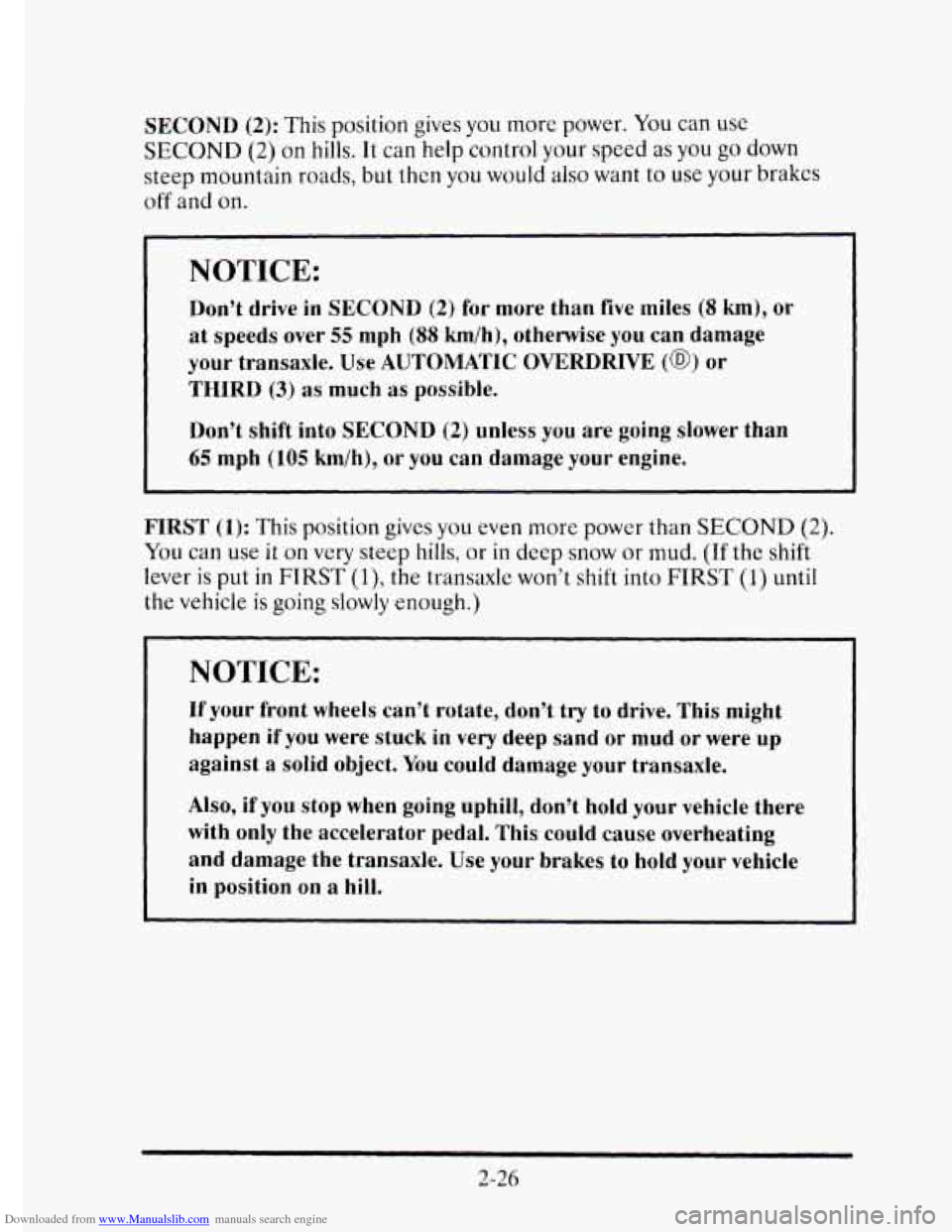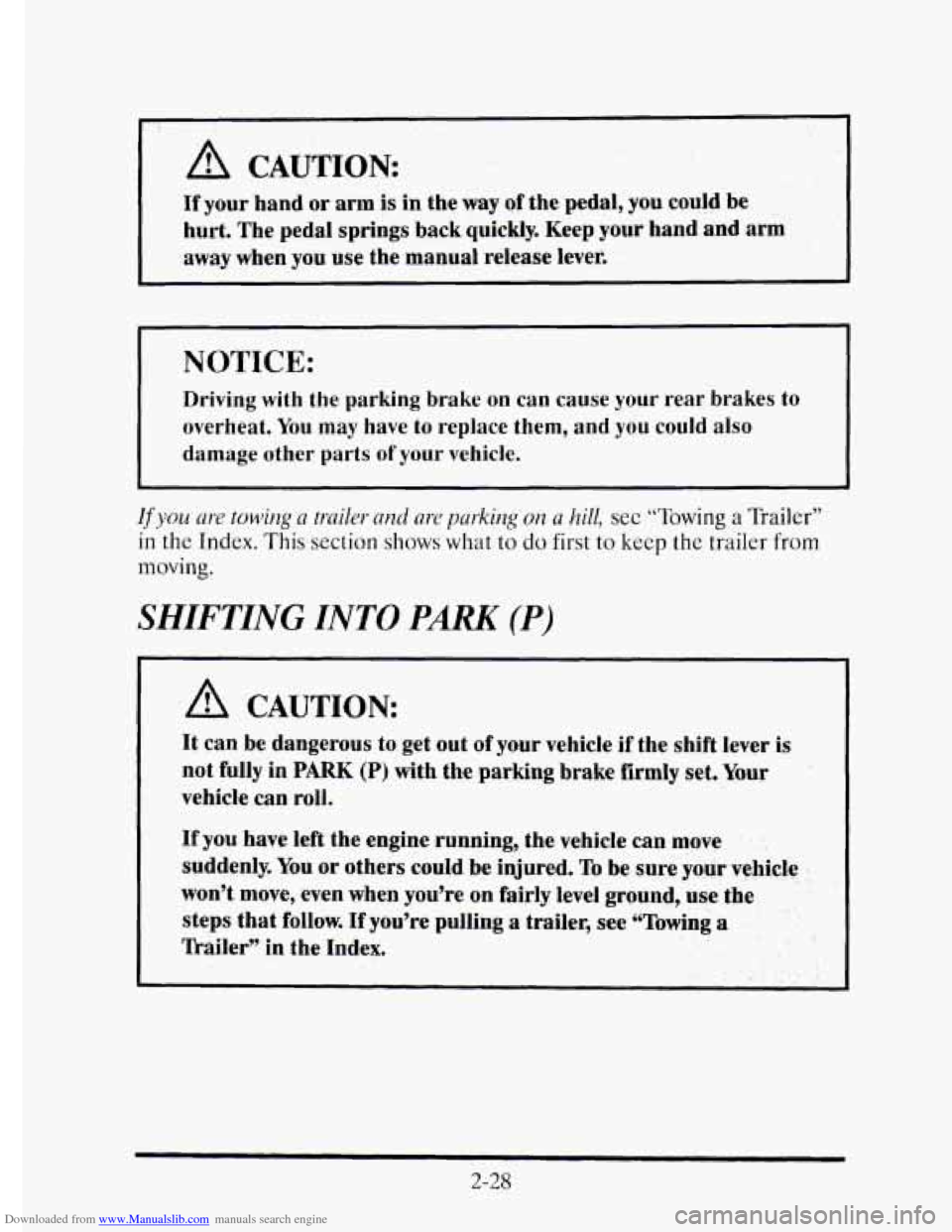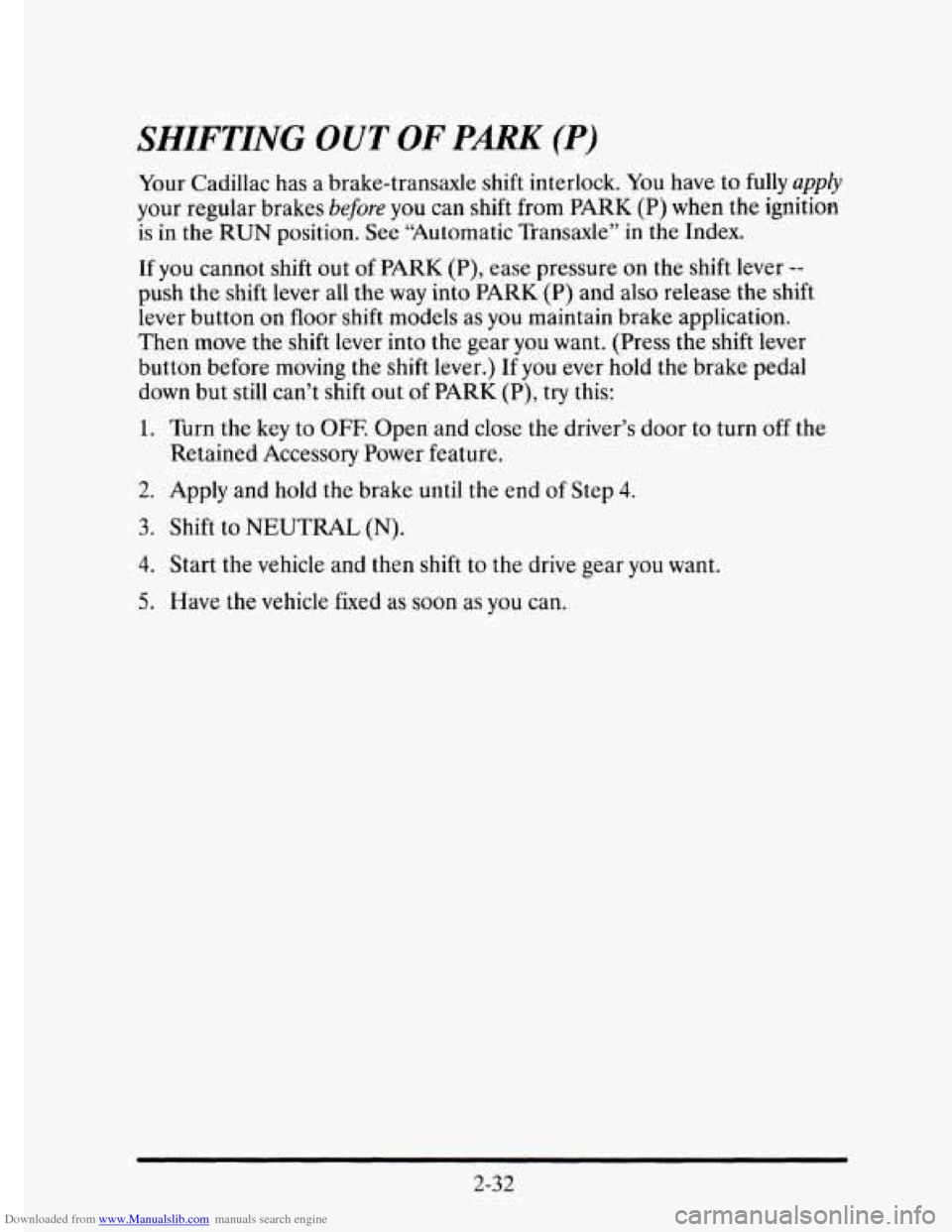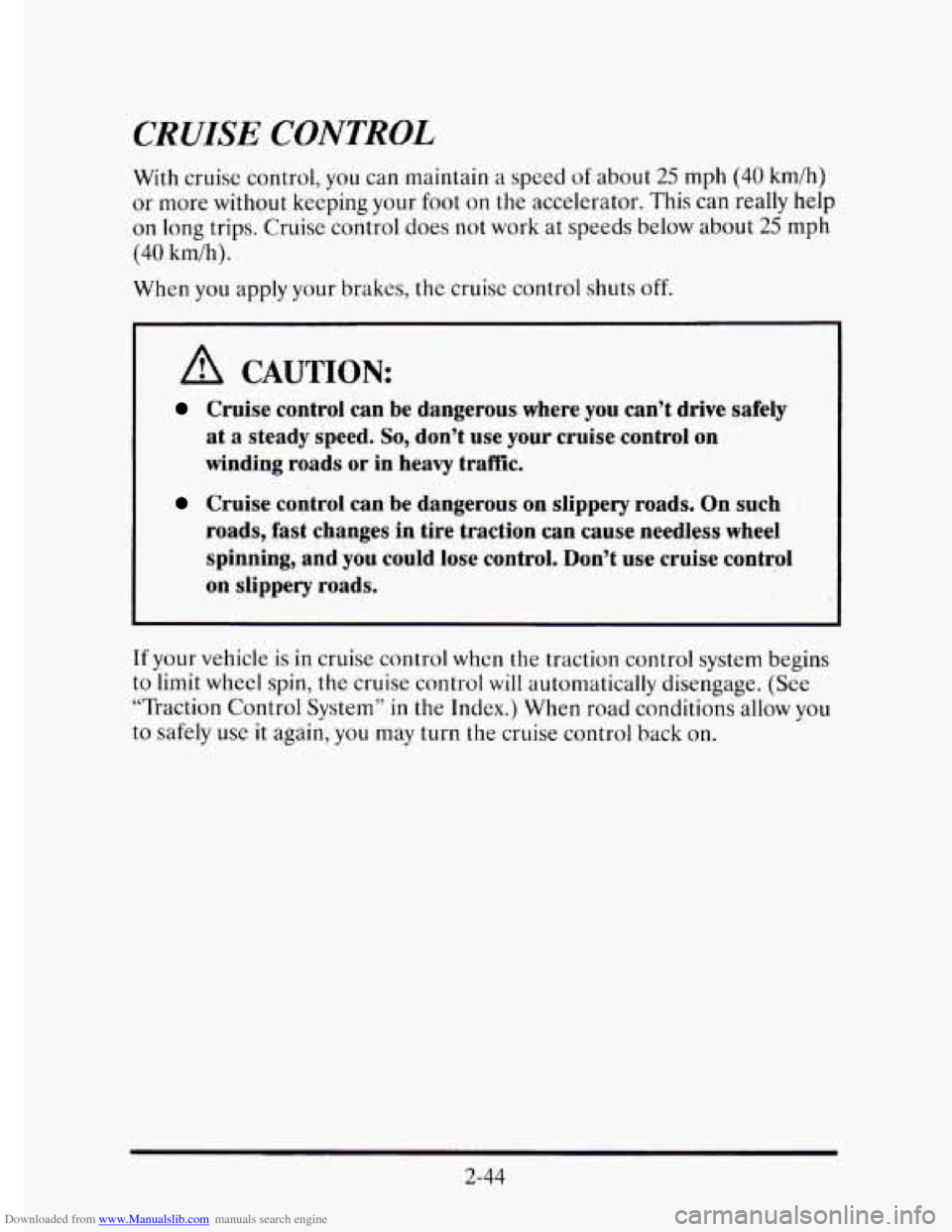1995 CADILLAC ELDORADO brakes
[x] Cancel search: brakesPage 9 of 395

Downloaded from www.Manualslib.com manuals search engine This rich tradition continues
into
the '90s as Cadillac became the
first automobile trnnufacturer to be
awarded the prestigious Malcolm
Baldrige National Quality Award.
The 1992 Seville STS was the
iirst car' ever to win all three major
automotive awards: Car
of the Year,
Motor Trend; Ten Best List, Car ck
Driver; Car of the Year, Automobile
Magazine.
A 1993 Cadillac Ahanti in stock.
technical configuration.
wax selected
as the pace car for the 76th Inilianap-,
dis 500 The demanding pace car
performance and handling require-
menes were mer becausc of such
advances as the Northstar system.
The system includes the 32 valve,
dual ovcrhead camshaft, Northstar
4,.6 liter V8 engine, 4T80 E electroni--
cally controlled automatic transaxle,
road sensing
suspension, speed sen-
sltive steering, antilock brakes and
traction control.
For more than nine decades
Cadillac
has been a leader in quality
and technical innovation. Now more
than ever, substance takes
shape
, is:. -... :. , - .:;: i!
Page 95 of 395

Downloaded from www.Manualslib.com manuals search engine Ensure the shift lever is fully in PARK (P) range before starting the
engine. Your Cadillac has
a brake-transaxle shift interlock. You have to
fully apply your regular brakes befure you can shift from PARK (P) when
when the ignition key is
in the RUN position. If you cannot shift out of
PARK (P), ease pressure on the shift lever -- push the shift lever all the
way into PARK (P) and release the shift lever button
on the floor shift
console models as you maintain brake application. Then move the shift
lever into the gear you wish. (Press the shift lever button before moving
the shift lever
on floor shift console models.) See “Shifting Out of
PARK (P)” in this section.
REVERSE (R): Use this gear to back up.
NOTICE:
Shifting to REVERSE (R) while your vehicle is moving forward
could damage
your transaxle. Shift to REVERSE (R) only after
your vehicle
has stopped.
Also use this gear to rock your vehicle back and forth to get out of snow,
ice or sand without damaging your transaxle. See “If You’re Stuck in
Sand,
Mud, Ice or Snow” in the Index for additional information.
NEUTRAL, (N): In this position, your engine doesn’t connect with the
wheels.
To restart when you’re already moving, use NEUTRAL (N) only.
Also, use NEUTRAL (N) when your vehicle is being towed.
2-24
1
1
a
Page 97 of 395

Downloaded from www.Manualslib.com manuals search engine SECOND (2): This position gives you more power. You can use
SECOND (2) on hills. It can help control your speed as you go down
steep mountain roads, but then you would also want to use your brakes
off and on.
NOTICE:
Don’t drive in SECOND (2) for more than five miles (8 km), or
at speeds over 55 mph (88 km/h), otherwise you can damage
your transaxle.
Use AUTOMATIC OVERDRIVE (@) or
THIRD (3) as much as possible.
Don’t shift into
SECOND (2) unless you are going siower man
65 mph (105 km/h), or you can damage your engine.
FIRST
(1): This position gives you even more power than SECOND (2).
You can use it on very steep hills, or in deep snow or mud. (If the shift
lever is put
in FIRST (I), the transaxle won’t shift into FIRST (1) until
the vehicle is going slowly enough.)
NOTICE:
If your front wheels can’t rotate, don’t try to drive. This might
happen
if you were stuck in very deep sand or mud or were up
against a solid object. You could damage your transaxle.
Also,
if you stop when going uphill, don’t hold your vehicle there
with only the accelerator pedal. This could cause overheating
and damage the transaxle. Use your brakes to
hold your vehicle
in position on a
hill.
2-26
Page 99 of 395

Downloaded from www.Manualslib.com manuals search engine A, CAUTION:
If your hand or arm is in the way of the pedal, you could be
hurt.
The pedal springs back quickly. Keep your hand and arm
away when
you use the manual release lever.
I NOTICE:
Driving with the parking brake on can cause your rear brakes to
overheat. You may have to replace them, and you could also
damage other parts
of your vehicle.
If you are towirg u truiler and are parking on a hill, see “Towing a Trailer”
in the Index. This section slmws what to do first to kecp the trailer from
moving.
SHIFTING INTO PARK (P)
A CAUTION:
It can be dangerous to get out of your vehicle if the shift lever is
not fully in PARK (P) with the parking brake firmly set. Your
vehicle can roll.
If you have left the engine running, the vehicle can move ’’
suddenly. You or others could be injured. To be sure your vehicle
won’t
move, even when you’re on fairly level ground, use the
steps that follow.
If you’re pulling a trailer, see “Towing a
ll-ailer” in the Index.
.. ...
2-28
Page 103 of 395

Downloaded from www.Manualslib.com manuals search engine SHIFTING OUT OF PRRK (P)
Your Cadillac has a brake-transaxle shift interlock. You have to fully apply
your regular brakes before you can shift from PARK (P) when the ignitioa
is
in the RUN position. See “Automatic Transaxle” in the Index.
If you cannot shift out of PARK (P), ease pressure on the shift lever --
push the shift lever all the way into PARK (P) and also release the shift
lever button on
floor shift models as you maintain brake application.
Then move the shift lever into the gear you want. (Press the shift lever
button before moving the shift lever.) If you ever hold the brake pedal
down but still can’t
shift out of PARK (P), try this:
1. Turn the key to OFE Open and close the driver’s door to turn off the
2. Apply and hold the brake until the end of Step 4.
3. Shift to NEUTRAL (N).
4. Start the vehicle and then shift to the drive gear you want.
5. Have the vehicle fixed as soon as you can.
Retained
Accessory Power feature.
2-32
Page 115 of 395

Downloaded from www.Manualslib.com manuals search engine CRUISE CONTROL
With cruise control, you can maintain a speed of about 25 rnph (40 km/h)
or more without keeping your foot on the accelerator. This can really help
on long trips. Cruise control does
not work at speeds below about 25 rnph
(40 km/h).
When
you apply your brakes, the cruise control shuts off.
A CAUTION:
Cruise control can be dangerous where you can’t drive safely
at a steady speed. So, don’t use your cruise control on
winding roads or
in heavy traf‘fic.
Cruise control can be dangerous on slippery roads. On such
roads, fast changes in tire traction can cause needless wheel
spinning, and you could lose control. Don’t use cruise control
on slippery roads.
If your vehicle is in cruise control when the traction control system begins
to limit wheel spin, the cruise control will automatically disengage. (See
“Traction Control System”
in the Index.) When road conditions allow you
to safely use it again, you may turn the cruise control back on.
2-44
Page 148 of 395

Downloaded from www.Manualslib.com manuals search engine Anti-Lock Brake System Warning Light
ANTI-
LOCK (@)
With the anti-lock brake system, this light will come on when you start
your engine and may stay
on for several seconds. That’s normal. If the
light doesn’t come on, have it fixed
so it will be ready to warn you if there
is a problem.
If the light stays on, turn the ignition off. Or, if the light comes on when
you’re driving, stop as soon as possible and turn the ignition
off. Then
start the engine again
to reset the system. If the light still stays on, or
comes on again while you’re driving, your Cadillac needs service. If the
regular brake system warning light isn’t
on, you still have brakes, but you
don’t have anti-lock brakes. If the regular brake system warning light is
also on,
you don’t have anti-lock brakes and there’s a problem with your
regular brakes. See “Brake System Warning Light” earlier
in this part.
Traction Disabled Message
If this message is displayed, there’s a problem with your traction control
system and your vehicle needs service. When this message
is displayed,
the system
will not limit wheel spin. Adjust your driving accordingly.
Traction Control System Active Message
When your traction control system is limiting wheel spin, the TRACTION
ACTIVE message will be displayed. Slippery road conditions may exist if
this message is displayed, so adjust your driving accordingly. This message
will stay
on for a few seconds after the traction control system stops
limiting wheel spin.
2-77
Page 192 of 395

Downloaded from www.Manualslib.com manuals search engine CONTROL OF A VEHICLE
You have three systems that make your vehicle go where you want it to go.
They are the brakes, the steering and the accelerator. All three systems
have to do their work at the places where the tires meet the road.
. . ..-
Sometimes, as when you’re driving on snow or ice, it’s easy to ask more of
those control systems than the tires and road can provide. That means you
can lose control
of your vehicle.
BRAKING
Braking action involves perception time and reaction time.
First, you have to decide
to push on the brake pedal. That’sperception
time. Then you have to bring up your
foot and do it. That’s reaction time.
Average reaction time is about
314 of a second. But that’s only an average.
It might be less with one driver and as long as
two or three seconds or
more with another.
Age, physical condition, alertness, coordination, and
eyesight all play a part.
So do alcohol, drugs and frustration. But even in
3/4 of a second, a vehicle moving at 60 mph (100 km/h) travels 66 feet
(20 m). That could be a lot of distance in an emergency, so keeping
enough space between your vehicle and others is important.
And,
of course, actual stopping distances vary greatly with the surface of
the road (whether it’s pavement or gravel); the condition of the road (wet,
dry, icy); tire tread; and the condition
of your brakes.
4-5